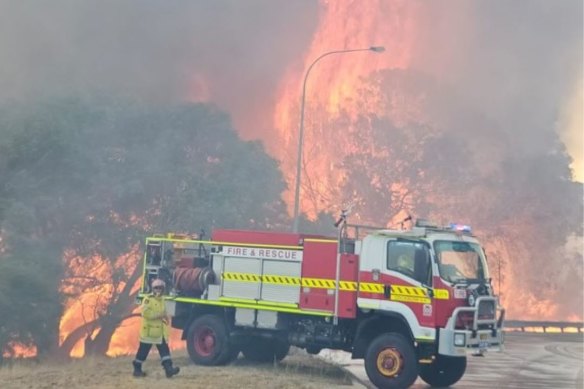By Emma Young
Authorities have implored West Australians to create fire plans, predicting an unprecedented extension of the south-west’s bushfire season throughout autumn.
An outlook released on Friday shows the hot, dry, windy conditions the south-west land division experienced over summer will continue over autumn.

A bushfire menaced suburban homes in Bibra Lake on February 20.Credit: DFES
The West Kimberley is also expected to face above-average risk, given its recent low rainfall.
“For the department, it’s been a long and fairly challenging fire season,” said Deputy Fire and Emergency Services Commissioner Craig Waters.
Waters said WA had for three or four seasons been seeing an overlap of the northern and southern bushfire seasons, which was now the “new normal”.
He said this extension of the south-west’s bushfire season into autumn was the next precedent being set.
The season had 30 more fires than the same period last year, bringing the total to more than 3700, Waters said.
Thirty of these reached emergency warning level.
Soils were drier, with a soil moisture deficit this year far outweighing the five-year average.
“Fuel is just ready to go. As soon as there’s an ignition source introduced into that heavy and dry fuel load, they just take off,” he said.
“We’ve seen now for probably the last three or four or five seasons, not only an increase in the number of fires that are occurring, but also an increase in the intensity and ferocity.”
These conditions, and the overlapping of the two normally distinct seasons in the north and south, have put pressure on resources normally moved between the two regions.
Authorities brought aircraft online a month early last October.
Last week, they decided to extend use of the large air tanker until the end of March, and Helitak and Blackhawk helicopters to the end of April.
This fleet has already dropped more than 12 million litres of retardant and water in support of frontline firefighters. The WA and national large air tanker combined have also delivered over 800,000 litres of retardant and water.
Waters said fatigued firefighters also needed careful management, and authorities were frustrated that while 93 per cent of West Australians were living in bushfire-prone areas, only about 1.5 per cent of them had completed the Department of Fire and Emergency Services bushfire planning tool.
Tens of thousands had begun a plan but not completed it, despite a significant awareness-raising campaign.
“There’s just a level of complacency, especially in the metropolitan area.
“Fires happen anywhere in the state … make sure you develop a plan. It takes 15 minutes, you know, it doesn’t take long at all.”
Waters said the Wooroloo fire’s ember attacks were 2-3 kilometres ahead of the front, so not only people whose homes abutted bushland needed to prepare.
“The last thing we want is people making those bad decisions when they’re being approached by bushfire coming up to their property,” he said.
“It’s those people we’ve seen historically that act late and leave late, they’re the ones where we see fatalities occurring.”
DFES’ map of bushfire prone areas in WA can be found here and the “my bushfire plan” tool here.
Read more
The big change coming to your morning coffee as WA plastics ban ramps up
Peak WA doctors’ body splinters from national group in ugly spat over membership money
‘Disclosure issues’: Magistrate unhappy as Marlion Pickett’s court case stalls again
Start the day with a summary of the day’s most important and interesting stories, analysis and insights. Sign up for our Morning Edition newsletter.